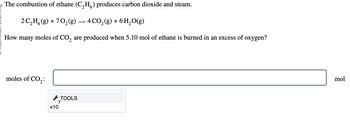
Chemistry
10th Edition
ISBN: 9781305957404
Author: Steven S. Zumdahl, Susan A. Zumdahl, Donald J. DeCoste
Publisher: Cengage Learning
expand_more
expand_more
format_list_bulleted
Concept explainers
Question

Transcribed Image Text:The combustion of ethane (C₂H) produces carbon dioxide and steam.
2 C₂H6(g) +70₂(g) → 4 CO₂ (g) + 6H₂O(g)
How many moles of CO₂ are produced when 5.10 mol of ethane is burned in an excess of oxygen?
moles of CO₂:
x10
TOOLS
mol
Expert Solution
This question has been solved!
Explore an expertly crafted, step-by-step solution for a thorough understanding of key concepts.
This is a popular solution
Trending nowThis is a popular solution!
Step by stepSolved in 3 steps with 1 images

Knowledge Booster
Learn more about
Need a deep-dive on the concept behind this application? Look no further. Learn more about this topic, chemistry and related others by exploring similar questions and additional content below.Similar questions
- Ammonia gas can be prepared by the following reaction: CaO(s) + 2 NH4Cl(s) → 2 NH3 (g) + H₂O(g) + CaCl₂ (s) If 314 g of CaO and 628 g of NH4Cl are mixed, the theoretical yield of NH3 is 191 g. If only 133 g of NH3 is actually obtained, what is its percent yield? %arrow_forwardNitrogen and hydrogen combine at a high temperature, in the presence of a catalyst, to produce ammonia 2 NH, (g) N2 (g)3 H2 (g) There are four molecules of nitrogen and nine molecules of hydrogen present in the diagram When the reaction is complete, how many molecules of NH are produced? What is the limiting reactant? molecules of NH2: nitrogen hydrogen How many molecules of each reactant are remain after the reaction is complete? molecules of N,: molecules of H,:arrow_forwardHow do you calculate the theoretical yield in a chemical equation? Please mention the steps and actual calculations on a calculator with the equation formula and use this question as an example 112 g of nitrogen gas reacts with hydrogen gas to produce 40.8 g of ammonia gas according to the equation given below: N2(g) + 3H2(g) ⇋ 2NH3(g)arrow_forward
- Gaseous methane CH4 reacts with gaseous oxygen gas O2 to produce gaseous carbon dioxide CO2 and gaseous water H2O. If 2.80g of carbon dioxide is produced from the reaction of 1.44g of methane and 11.3g of oxygen gas, calculate the percent yield of carbon dioxide.arrow_forwardNitric oxide (NO) reacts with oxygen gas to form nitrogen dioxide (NO2), a dark-brown gas: 2NO(g) + O (g) ⟶ 2NO (g) In one experiment 0.886 mole of NO is mixed with 0.503 mole of O2. Calculate which of the two reactants is the limiting reactant. Calculate also the number of moles of NO2 produced.arrow_forwardFor the following reaction, 6.70 grams of benzene (C6H6) are mixed with excess oxygen gas. The reaction yields 18.0 grams of carbon dioxide. benzene (C6H6) (l) + oxygen (g) →→→carbon dioxide (g) + water (g) What is the theoretical yield of carbon dioxide ? What is the percent yield of carbon dioxide ? grams %arrow_forward
- A chemist mixes 14.10(g) of C8H18 with 72.45(g)O2 here is the balanced equation 2C8H18(g)+25O2(g)→16CO2(g)+18H2O(g) Identify the limiting reactionarrow_forwardHow many grams of Fe are produced when 65.0 grams of iron (lll) oxide is reacted with 52.3 grams of carbon monoxide according to the the following balanced equation. Fe2O3 (s) + 3CO (g) --> 2 Fe (s) + 3 CO2 (g)arrow_forwardAl2Cl6 is made by treating scrap metal with chlorine gas according to the following equation: 2 Al (s) + 3 Cl2 (g) ⟶⟶ Al2Cl6 (s) In the reaction of 251.4 g Cl2 with 129.7 g Al, determine the limiting reactant and theoretical yield of the product. The limiting reactant is ?. The theoretical yield of Al2Cl6 is ? g. Round the answer to 1 decimal place. If the reaction produces 278.0 g Al2Cl6, calculate the percent yield of the reaction. Answer in % Round the answer to 1 decimal place.arrow_forward
- Gaseous ethane CH3CH3 reacts with gaseous oxygen gas O2 to produce gaseous carbon dioxide CO2 and gaseous water H2O . If 5.05g of carbon dioxide is produced from the reaction of 4.21g of ethane and 30.7g of oxygen gas, calculate the percent yield of carbon dioxide.arrow_forwardn the reaction below, 7.0 mol of NO and 5.0 mol of O₂ are reacted together. The reaction generates 3.5 mol of NO₂. What is the percent yield for the reaction? 2 NO (g) + O₂ (g) → 2 NO₂ (g)arrow_forwardded for this question. When iron(III) oxide reacts with aluminum, aluminum oxide and iron are produced. The balanced equation for this reaction is: Fe2O3 (8)+2Al(s) → Al2O3 (8) + 2Fe(8) If 4 moles of aluminum react, The reaction consumes The reaction produces moles of iron(III) oxide. moles of aluminum oxide and moles of iron.arrow_forward
arrow_back_ios
SEE MORE QUESTIONS
arrow_forward_ios
Recommended textbooks for you
 ChemistryChemistryISBN:9781305957404Author:Steven S. Zumdahl, Susan A. Zumdahl, Donald J. DeCostePublisher:Cengage Learning
ChemistryChemistryISBN:9781305957404Author:Steven S. Zumdahl, Susan A. Zumdahl, Donald J. DeCostePublisher:Cengage Learning ChemistryChemistryISBN:9781259911156Author:Raymond Chang Dr., Jason Overby ProfessorPublisher:McGraw-Hill Education
ChemistryChemistryISBN:9781259911156Author:Raymond Chang Dr., Jason Overby ProfessorPublisher:McGraw-Hill Education Principles of Instrumental AnalysisChemistryISBN:9781305577213Author:Douglas A. Skoog, F. James Holler, Stanley R. CrouchPublisher:Cengage Learning
Principles of Instrumental AnalysisChemistryISBN:9781305577213Author:Douglas A. Skoog, F. James Holler, Stanley R. CrouchPublisher:Cengage Learning Organic ChemistryChemistryISBN:9780078021558Author:Janice Gorzynski Smith Dr.Publisher:McGraw-Hill Education
Organic ChemistryChemistryISBN:9780078021558Author:Janice Gorzynski Smith Dr.Publisher:McGraw-Hill Education Chemistry: Principles and ReactionsChemistryISBN:9781305079373Author:William L. Masterton, Cecile N. HurleyPublisher:Cengage Learning
Chemistry: Principles and ReactionsChemistryISBN:9781305079373Author:William L. Masterton, Cecile N. HurleyPublisher:Cengage Learning Elementary Principles of Chemical Processes, Bind...ChemistryISBN:9781118431221Author:Richard M. Felder, Ronald W. Rousseau, Lisa G. BullardPublisher:WILEY
Elementary Principles of Chemical Processes, Bind...ChemistryISBN:9781118431221Author:Richard M. Felder, Ronald W. Rousseau, Lisa G. BullardPublisher:WILEY

Chemistry
Chemistry
ISBN:9781305957404
Author:Steven S. Zumdahl, Susan A. Zumdahl, Donald J. DeCoste
Publisher:Cengage Learning

Chemistry
Chemistry
ISBN:9781259911156
Author:Raymond Chang Dr., Jason Overby Professor
Publisher:McGraw-Hill Education

Principles of Instrumental Analysis
Chemistry
ISBN:9781305577213
Author:Douglas A. Skoog, F. James Holler, Stanley R. Crouch
Publisher:Cengage Learning

Organic Chemistry
Chemistry
ISBN:9780078021558
Author:Janice Gorzynski Smith Dr.
Publisher:McGraw-Hill Education

Chemistry: Principles and Reactions
Chemistry
ISBN:9781305079373
Author:William L. Masterton, Cecile N. Hurley
Publisher:Cengage Learning

Elementary Principles of Chemical Processes, Bind...
Chemistry
ISBN:9781118431221
Author:Richard M. Felder, Ronald W. Rousseau, Lisa G. Bullard
Publisher:WILEY